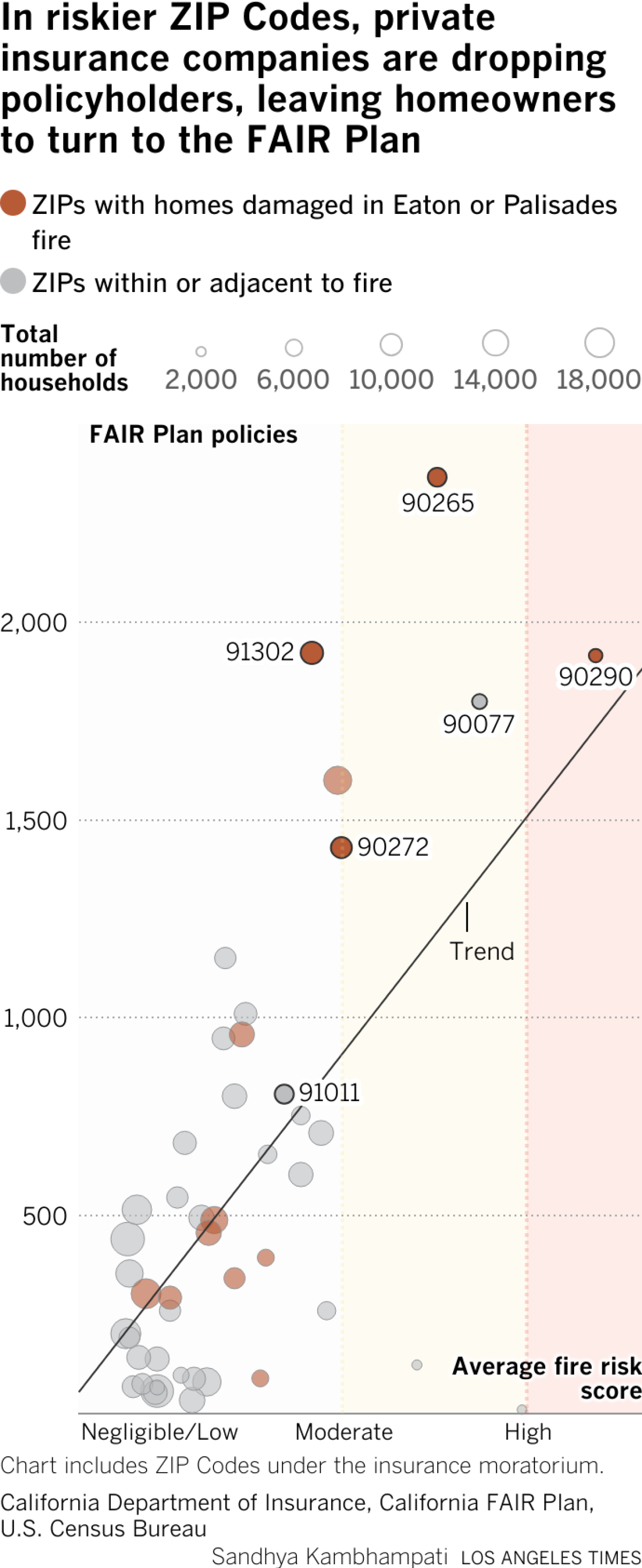Good morning. Here’s what you need to know to start your day.
Newsletter
You’re reading the Essential California newsletter
The most important California stories and recommendations in your inbox every morning.
You may occasionally receive promotional content from the Los Angeles Times.
Homeowners are paying the price for California’s risky insurance market
If California property owners are denied coverage from commercial insurance companies, they turn to the state’s insurer of last resort.
Ratepayers on the FAIR Plan are typically hit with higher premiums for homes and other properties deemed to hold higher risk of catastrophic fire, paying more for basic coverage.
As traditional insurance companies retreated from an increasingly risky California market, statewide enrollment in the FAIR plan surged, nearly doubling between September 2021 and September 2024.

And as Times reporter Laurence Darmiento and data journalist Sandhya Kambhampati lay out in a new Times subscriber exclusive, residents in Pacific Palisades and Altadena were part of that swell.
Among properties in the Palisades and Eaton fire zones, the FAIR Plan’s rolls shot up last year by a combined 47% to 28,440 homes, they reported, nearly double the properties enrolled in 2020.
Now many fire survivors who lost their homes are relying on the insurer of last resort to help them recover from their worst nightmare.
“For many victims of the L.A.-area wildfires, it was the only available insurance: Four ZIP Codes in the fire-affected zones enrolled more than a third of their households in the state plan,” Laurence and Sandhya wrote. “But the backup insurance has not lived up to its promise, drawing numerous complaints among policyholders about delays in payments and other issues.”

California’s insurance crisis reaches a tipping point
Back in 2023, Allstate and State Farm announced they would stop offering new policies for properties in the Golden State. Officials from State Farm — the state’s longtime top home insurer — cited “rapidly growing catastrophe exposure and a challenging reinsurance market.”
The insurers’ actions were a response to what scientists have been telling us: Human-caused climate change is intensifying wildfires and other environmental disasters. Covering homes in increasingly dry, fuel-rich forests, on cliffs that don’t stay put and at the edge of the coast as sea levels rise is a business that’s only getting riskier.
The pullback by big insurers sparked that surge in FAIR Plan enrollment, but the state’s exposure grew larger than it was designed to be, Laurence and Sandhya noted.
“The FAIR Plan was established by the Legislature in 1968 to offer basic insurance in urban and fire-prone neighborhoods where it was not available,” they wrote. “It was not meant to be a large participant in the state’s home insurance market, but a string of disastrous wildfires over the last decade has spooked private insurers.”
As of March, there are 556,000 homeowner policies and nearly 18,000 commercial policies on the FAIR Plan, “making it one of the state’s biggest home insurers and exposing it to large losses,” they added.

Homes destroyed by the Jan. 7, 2025, fire that broke out in Pacific Palisades.
(Eric Thayer / For The Times)
The FAIR Plan’s losses could end up costing ratepayers across the state
To date, FAIR Plan officials say they’ve received about 5,280 damage claims related to the Palisades and Eaton fires and paid out more than $2.5 billion to policyholders, my colleagues reported.
“The plan expects that the Jan. 7 fires will cost it an estimated $4 billion,” they noted.
In the face of those losses, the program is now seeking a $1-billion bailout, which would be initially paid for by assessing commercial insurers that operate in the state.
But if that happens, policyholders across California could end up paying more, as a new state policy would allow State Farm, Allstate and other insurance companies to recoup half of their assessments by charging their ratepayers.
You can read more from Laurence and Sandhya in their Times subscriber exclusive.
Today’s top stories

Yolanda Rubio, parent and teachers aid, plays with a child in the Early Head Start program at Pacific Clinics Head Start in Pasadena.
(Allen J. Schaben / Los Angeles Times)
With Head Start in jeopardy, the Trump administration threatens child care for 800,000 kids
- A leaked draft of the administration’s budget proposal for the Department of Health and Human Services would defund Head Start and phase the program out by 2026, a move that would slash a crucial safety net for families who otherwise could not afford child care and the other comprehensive services they receive.
‘It is time for you to leave’: DHS mistakenly sends notices to U.S. citizens
What else is going on
Get unlimited access to the Los Angeles Times. Subscribe here.
This morning’s must reads

Dhar Mann, right, talks with his longtime head production manager Ruben Ortiz in one of the stages at Dhar Mann Studios in Burbank. Mann began his career posting videos to YouTube in 2018.
(Jason Armond / Los Angeles Times)
YouTube turns 20 years old. How it changed TV as we know it. From modest beginnings, the site opened the gates for users around the world to post funny, viral videos that could take the internet by storm, racking up millions of views and earning some millions of dollars. YouTube has evolved into not merely a tech operation, but also a formidable force in television.
Other must reads
How can we make this newsletter more useful? Send comments to essentialcalifornia@latimes.com.
For your downtime

Alec Cohen, who calls himself the Gay Choreographer, leads his signature Intro to Popstar Dance class at the Pickle Factory at the Frogtown Creative compound in early April.
(Kit Karzen / For The Times)
Going out
Staying in
A question for you: What would you ask your favorite author?
With the L.A. Times Book Festival coming up this weekend, we want to know what you’d ask your favorite authors.
Email us at essentialcalifornia@latimes.com, and your response might appear in the newsletter this week.
And finally … from our archives

Barbra Streisand photographed at her Malibu home in 2020.
(Collier Schorr)
On April 24, 1942, singer-actor-director Barbra Streisand was born. In March, The Times’ Jeanette Marantos wrote about a brand-new rose that popped up in Streisand’s garden. Only about 2,000 of the hybrid tea rose bushes, dubbed Barbra’s Baby, are available so far. More should be available in years to come.
Have a great day, from the Essential California team
Ryan Fonseca, reporter
Andrew Campa, Sunday reporter
Kevinisha Walker, multiplatform editor
Hunter Clauss, multiplatform editor
Christian Orozco, assistant editor
Karim Doumar, head of newsletters
Check our top stories, topics and the latest articles on latimes.com.

Alice J. Roden started working for Trending Insurance News at the end of 2021. Alice grew up in Salt Lake City, UT. A writer with a vast insurance industry background Alice has help with several of the biggest insurance companies. Before joining Trending Insurance News, Alice briefly worked as a freelance journalist for several radio stations. She covers home, renters and other property insurance stories.

